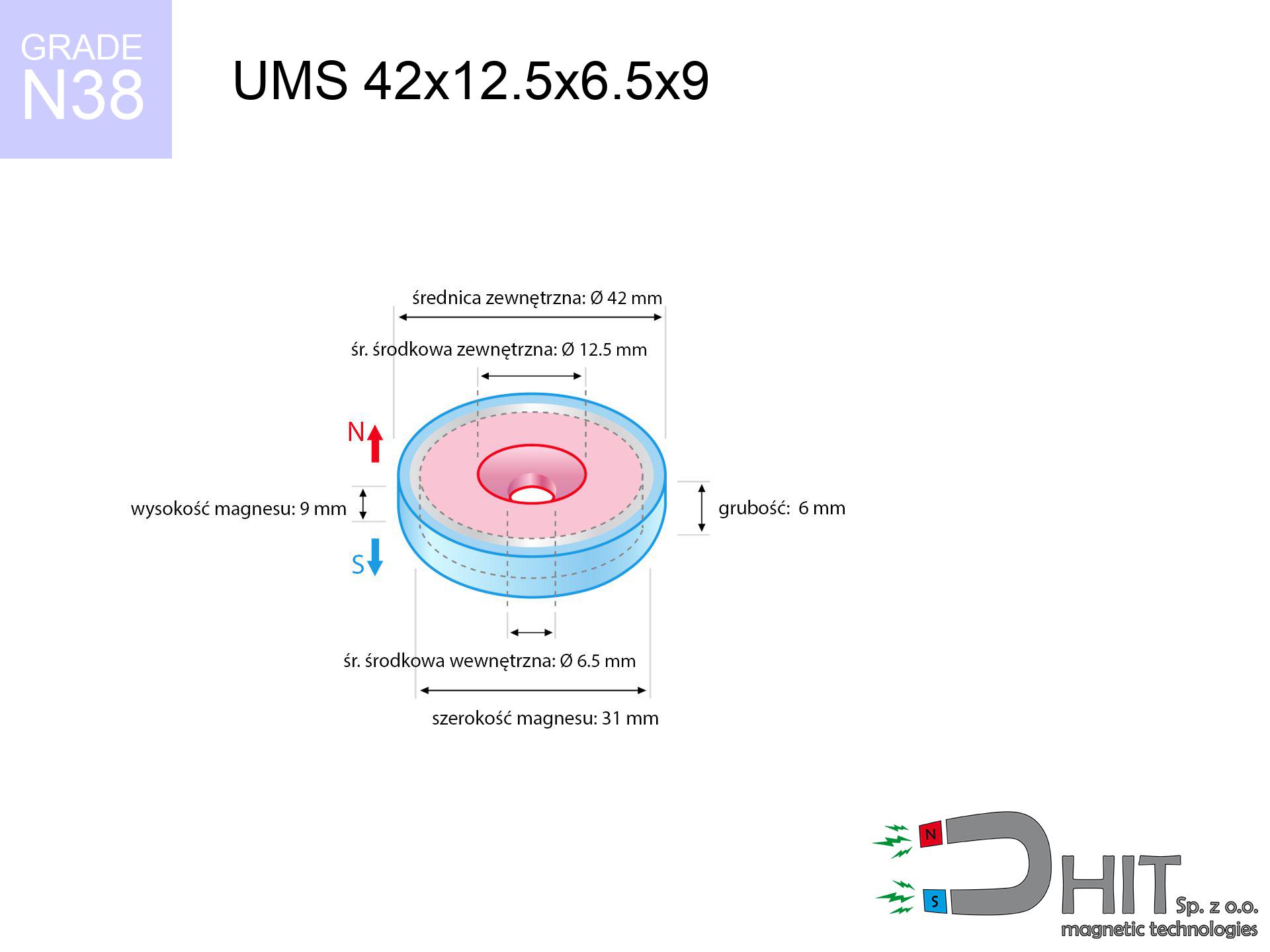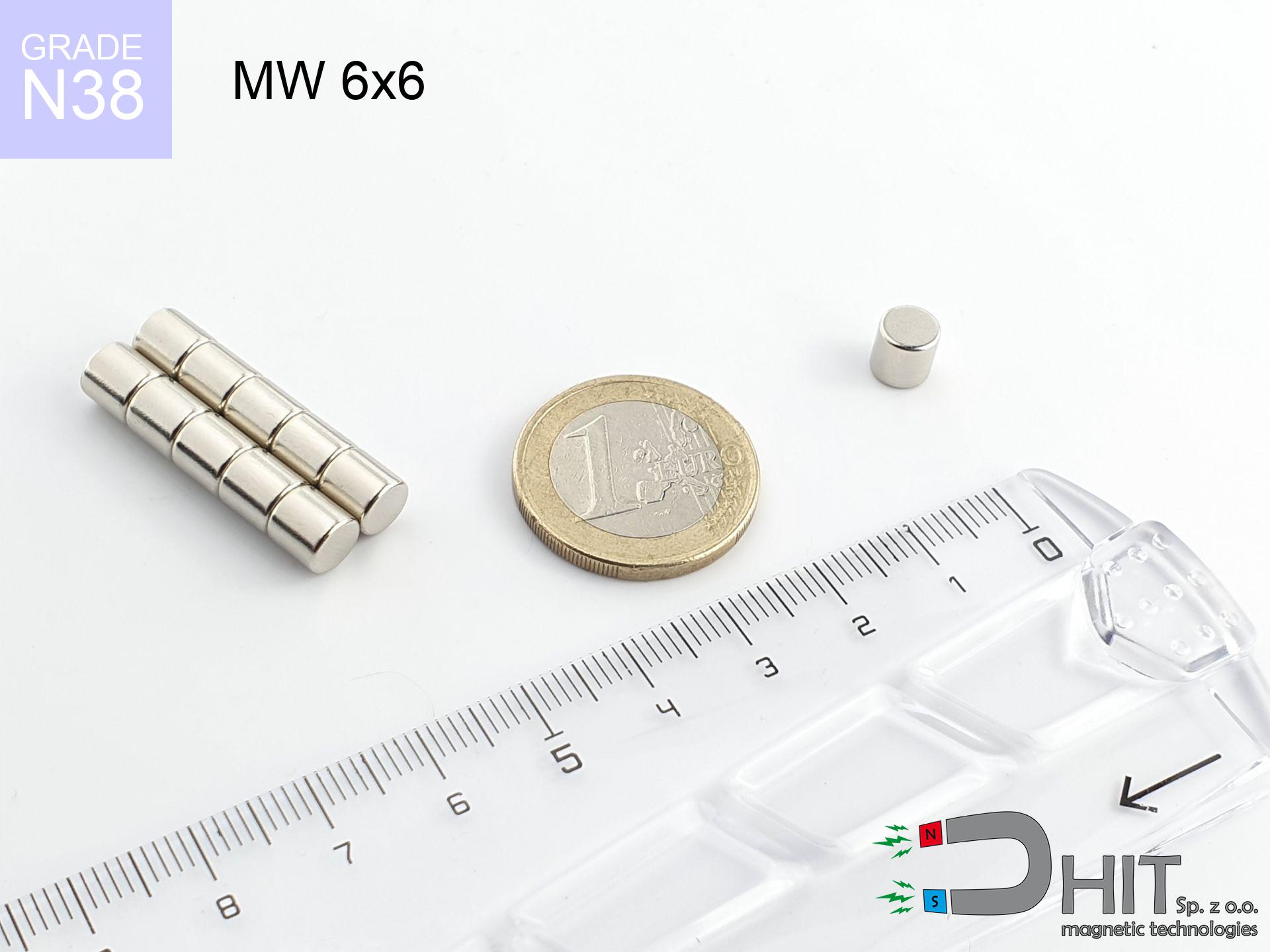UMS 42x12.5x6.5x9 / N38 - conical magnetic holder
conical magnetic holder
Catalog no 220331
GTIN: 5906301814214
Diameter Ø [±0,1 mm]
42 mm
cone dimension Ø [±0,1 mm]
12.5x6.5 mm
Height [±0,1 mm]
9 mm
Weight
72 g
Magnetization Direction
↑ axial
Load capacity
37 kg / 362.85 N
Coating
[NiCuNi] nickel
27.06 ZŁ with VAT / pcs + price for transport
22.00 ZŁ net + 23% VAT / pcs
bulk discounts:
Need more?Need help making a decision?
Call us
+48 22 499 98 98
alternatively send us a note using
inquiry form
through our site.
Strength and form of magnetic components can be analyzed using our
online calculation tool.
Orders placed before 14:00 will be shipped the same business day.
Magnetic properties of material N38
Physical properties of sintered neodymium magnets Nd2Fe14B at 20°C
Shopping tips
Advantages and disadvantages of neodymium magnets.
Apart from their superior magnetism, neodymium magnets have these key benefits:
- They have stable power, and over more than 10 years their performance decreases symbolically – ~1% (in testing),
- They maintain their magnetic properties even under close interference source,
- By covering with a smooth coating of nickel, the element has an proper look,
- Neodymium magnets ensure maximum magnetic induction on a small surface, which allows for strong attraction,
- Neodymium magnets are characterized by very high magnetic induction on the magnet surface and are able to act (depending on the form) even at a temperature of 230°C or more...
- Thanks to modularity in constructing and the capacity to modify to unusual requirements,
- Key role in modern industrial fields – they are utilized in magnetic memories, electromotive mechanisms, diagnostic systems, also technologically advanced constructions.
- Compactness – despite small sizes they offer powerful magnetic field, making them ideal for precision applications
Problematic aspects of neodymium magnets and ways of using them
- They are prone to damage upon heavy impacts. To avoid cracks, it is worth securing magnets in special housings. Such protection not only shields the magnet but also increases its resistance to damage
- Neodymium magnets demagnetize when exposed to high temperatures. After reaching 80°C, many of them experience permanent drop of strength (a factor is the shape as well as dimensions of the magnet). We offer magnets specially adapted to work at temperatures up to 230°C marked [AH], which are very resistant to heat
- Magnets exposed to a humid environment can corrode. Therefore when using outdoors, we suggest using water-impermeable magnets made of rubber, plastic or other material protecting against moisture
- Due to limitations in creating threads and complex shapes in magnets, we recommend using cover - magnetic mount.
- Health risk to health – tiny shards of magnets can be dangerous, in case of ingestion, which becomes key in the aspect of protecting the youngest. Furthermore, small components of these magnets can complicate diagnosis medical in case of swallowing.
- With budget limitations the cost of neodymium magnets is economically unviable,
Best holding force of the magnet in ideal parameters – what affects it?
The force parameter is a theoretical maximum value executed under specific, ideal conditions:
- with the application of a sheet made of special test steel, ensuring maximum field concentration
- possessing a thickness of at least 10 mm to ensure full flux closure
- with a plane perfectly flat
- without any air gap between the magnet and steel
- during detachment in a direction vertical to the mounting surface
- at temperature room level
Magnet lifting force in use – key factors
It is worth knowing that the application force will differ influenced by the following factors, in order of importance:
- Gap (between the magnet and the plate), since even a microscopic clearance (e.g. 0.5 mm) can cause a drastic drop in lifting capacity by up to 50% (this also applies to varnish, rust or dirt).
- Angle of force application – highest force is available only during perpendicular pulling. The shear force of the magnet along the surface is typically several times lower (approx. 1/5 of the lifting capacity).
- Base massiveness – too thin sheet does not close the flux, causing part of the power to be wasted to the other side.
- Metal type – not every steel reacts the same. High carbon content worsen the interaction with the magnet.
- Surface structure – the smoother and more polished the surface, the larger the contact zone and higher the lifting capacity. Roughness creates an air distance.
- Thermal environment – temperature increase causes a temporary drop of induction. It is worth remembering the maximum operating temperature for a given model.
* Lifting capacity testing was performed on a smooth plate of optimal thickness, under a perpendicular pulling force, however under parallel forces the holding force is lower. In addition, even a small distance {between} the magnet’s surface and the plate reduces the holding force.
Warnings
Magnetic media
Device Safety: Strong magnets can damage payment cards and delicate electronics (heart implants, medical aids, mechanical watches).
Bone fractures
Pinching hazard: The pulling power is so immense that it can cause blood blisters, pinching, and even bone fractures. Protective gloves are recommended.
Magnetic interference
Be aware: neodymium magnets produce a field that interferes with precision electronics. Maintain a safe distance from your phone, device, and GPS.
Medical implants
Health Alert: Neodymium magnets can turn off heart devices and defibrillators. Stay away if you have electronic implants.
Mechanical processing
Dust created during machining of magnets is flammable. Do not drill into magnets unless you are an expert.
Operating temperature
Standard neodymium magnets (N-type) lose magnetization when the temperature exceeds 80°C. This process is irreversible.
This is not a toy
These products are not intended for children. Swallowing a few magnets can lead to them pinching intestinal walls, which poses a severe health hazard and requires immediate surgery.
Beware of splinters
Despite metallic appearance, the material is brittle and cannot withstand shocks. Do not hit, as the magnet may crumble into hazardous fragments.
Allergy Warning
Medical facts indicate that nickel (the usual finish) is a strong allergen. If you have an allergy, refrain from touching magnets with bare hands and select encased magnets.
Powerful field
Be careful. Neodymium magnets act from a long distance and connect with massive power, often faster than you can react.
Caution!
More info about hazards in the article: Magnet Safety Guide.





![SM 32x200 [2xM8] / N42 - magnetic separator SM 32x200 [2xM8] / N42 - magnetic separator](https://cdn3.dhit.pl/graphics/products/sm-32x200-2xm8-fub.jpg)
![UI 33x13x4 [C311] / N38 - badge holder UI 33x13x4 [C311] / N38 - badge holder](https://cdn3.dhit.pl/graphics/products/ui33x13x4-c311-vub.jpg)
![UMP 75x25 [M10x3] GW F200 PLATINIUM / N52 - search holder UMP 75x25 [M10x3] GW F200 PLATINIUM / N52 - search holder](https://cdn3.dhit.pl/graphics/products/ump-75x25-m10x3-gw-f200-platinium-tav.jpg)

